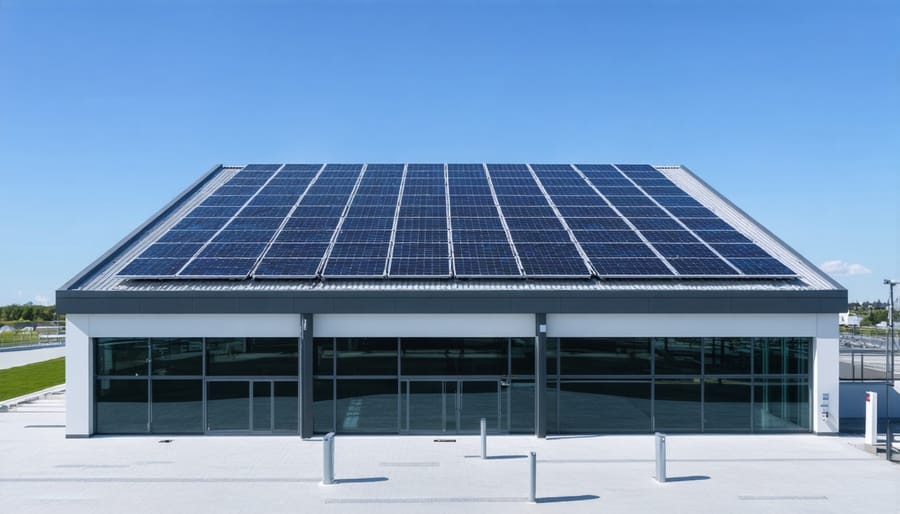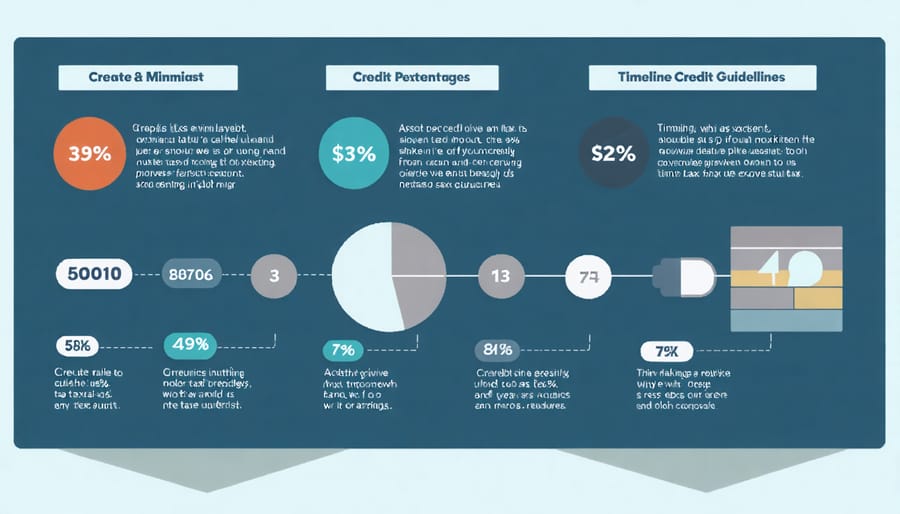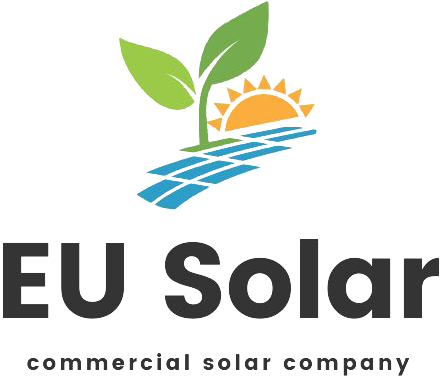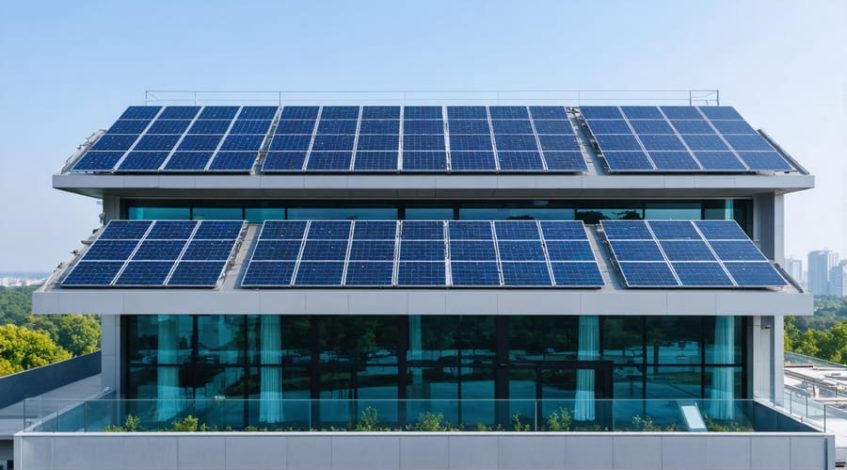Green energy tax credits represent a powerful financial catalyst for businesses considering sustainable energy investments in 2024. The Inflation Reduction Act has expanded these incentives significantly, offering up to 30% in federal tax credits for commercial solar installations, plus additional state-level benefits that can reduce total system costs by 40-60%. Forward-thinking companies leveraging these credits not only accelerate their return on investment but also position themselves competitively in an increasingly sustainability-focused market. Recent data shows businesses implementing solar solutions through tax credit programs achieve average payback periods of 3-5 years, while securing long-term energy independence and predictable operating costs. For facility managers and business owners, understanding and utilizing these tax incentives has become essential for strategic energy planning and fiscal responsibility.
This introduction targets business decision-makers with specific ROI figures, emphasizes current legislation, and maintains a professional tone while highlighting practical benefits. It avoids technical jargon while incorporating industry-relevant data and focusing on business outcomes.

Federal Solar Investment Tax Credit (ITC): Your Biggest Tax Savings Opportunity
Current ITC Rates and Timeline
Under the Inflation Reduction Act (IRA), the Investment Tax Credit (ITC) rates have been significantly enhanced, offering substantial incentives for commercial solar installations. According to the latest ITC updates, the base rate starts at 30% and can increase up to 50% when specific criteria are met.
Projects beginning construction in 2024 qualify for the following rates:
– Base rate: 30% for systems 1MW or larger
– Bonus 10% for domestic content requirements
– Additional 10% for projects in energy communities
– Extra 10% for installations in low-income communities
To qualify for maximum benefits, projects must meet prevailing wage and apprenticeship requirements. These enhanced rates are guaranteed through 2032, after which they will step down to 26% in 2033 and 22% in 2034.
Critical deadlines to note:
– Project must commence construction by December 31, 2024, for current rates
– Systems must be placed in service within 4 years of construction start
– Documentation of labor requirements must be maintained for 5 years
– Domestic content certification required before claiming additional credit
These incentives make 2024 an optimal time for businesses to invest in solar energy, with potential ROI accelerated through these substantial tax savings.

Qualification Requirements for Businesses
To qualify for the Investment Tax Credit (ITC), businesses must meet several key requirements established by the Internal Revenue Service. The facility must be located in the United States and construction must have begun within specified timeframes to claim the full credit percentage. Currently, commercial solar installations that begin construction before 2025 are eligible for the 30% credit.
Businesses must maintain detailed documentation, including proof of system ownership, itemized costs, and installation dates. Required records encompass equipment invoices, construction contracts, interconnection agreements, and building permits. The solar installation must also be new or being used for the first time – previously used equipment does not qualify.
The system must generate electricity for the business premises and meet all applicable safety and building codes. Companies must demonstrate “commenced construction” through either physical work of a significant nature or by meeting the Five Percent Safe Harbor test, which requires spending 5% or more of the total project costs.
For pass-through entities like partnerships and S-corporations, special rules apply regarding how the credit is allocated among partners or shareholders. The business must have sufficient tax liability to utilize the credit, though unused portions can be carried forward for up to 20 years.
Regular maintenance and continued operation of the solar system are required to avoid credit recapture. Annual documentation of system performance and upkeep should be maintained for at least five years after claiming the credit.
State-Specific Solar Incentives
How to Stack Multiple Incentives
To effectively maximize clean energy ROI, businesses should strategically combine multiple incentive programs. Start by identifying available federal tax credits, such as the Investment Tax Credit (ITC), which can be combined with accelerated depreciation benefits. Layer these with state-specific incentives, including property tax exemptions and performance-based incentives.
For optimal results, consider timing your installations to take advantage of seasonal or time-limited bonuses. Many utilities offer additional rebates that can be stacked with government incentives. Some states allow businesses to participate in both tax credit programs and renewable energy certificate (REC) markets simultaneously.
Remember to consult with tax professionals and energy consultants to ensure compliance with program requirements. Maintain detailed documentation of all qualifying expenses and installations. Consider phasing larger projects across multiple tax years to maximize available credits while managing cash flow effectively. This strategic approach can significantly reduce the overall cost of green energy implementation while accelerating your return on investment.
Commercial Solar Tax Credit Case Study
Midwest Manufacturing Solutions, a medium-sized manufacturing facility in Ohio, successfully implemented a 500kW solar installation in 2022, demonstrating how businesses can maximize the financial benefits of commercial solar through strategic tax credit utilization.
The company invested $875,000 in their solar installation project, which included rooftop panels and a ground-mounted array. By leveraging the Commercial Clean Energy Credit (formerly ITC), they qualified for a 30% tax credit worth $262,500. Additionally, they took advantage of bonus depreciation provisions, allowing them to deduct 80% of the system’s value in the first year.
The project’s timing proved crucial, as it coincided with the enhanced incentives provided by the Inflation Reduction Act. The company’s CFO worked closely with their tax advisors to ensure all documentation met IRS requirements and timing deadlines. They also secured state-level incentives, bringing their total tax benefits to approximately $350,000.
Key results after the first year of operation:
– Annual energy cost savings: $98,000
– Carbon emissions reduction: 450 metric tons
– Projected ROI timeline: 4.5 years
– Additional state tax benefits: $87,500
The success of this implementation has prompted the company to consider expanding their solar installation to additional facilities, demonstrating how strategic use of tax credits can transform sustainable energy initiatives into sound business investments while supporting environmental goals.
Additional Financial Incentives Beyond Tax Credits
Beyond federal tax credits, businesses can access numerous financial incentives to support their green energy initiatives. State-level grant programs often provide direct funding for renewable energy projects, with some offering matching funds of up to 50% of project costs. Many utility companies offer performance-based incentives (PBIs) that pay businesses for the actual energy their systems produce, creating an ongoing revenue stream.
Various solar financing options include equipment rebates, low-interest loans, and power purchase agreements (PPAs). Property Assessed Clean Energy (PACE) financing allows businesses to fund renewable energy improvements through property tax assessments, while accelerated depreciation programs enable rapid cost recovery on renewable energy investments.
Local governments frequently provide additional incentives such as reduced permit fees, expedited processing, and property tax exemptions for renewable energy installations. Some states also offer renewable energy certificates (RECs) that can be sold on the open market, providing another revenue stream for businesses investing in green energy technologies.

Steps to Claim Your Solar Tax Credits
To claim your solar tax credits, begin by maintaining comprehensive documentation of your solar installation project, including all receipts, contracts, and technical specifications. File IRS Form 3468 (Investment Credit) with your tax return for the Business Energy Investment Tax Credit (ITC). Ensure your system meets all eligibility requirements and was placed in service during the relevant tax year.
For state-specific credits, submit the required forms through your state tax authority’s designated channels. Most states require proof of installation completion, final inspection certificates, and verification that your system meets local building codes and energy efficiency standards.
Key documentation to prepare:
– Detailed cost breakdown of equipment and installation
– Proof of payment and contracts
– Technical specifications of solar equipment
– Installation completion certificate
– Building permits and inspection reports
– Energy production estimates
– Utility interconnection agreement
Consider engaging a qualified tax professional familiar with renewable energy incentives to ensure proper documentation and maximum credit utilization. Many credits can be carried forward if they exceed your tax liability in the current year, making proper documentation crucial for future claims.
Green energy tax credits represent a significant opportunity for businesses to transform their energy infrastructure while maximizing financial returns. By leveraging these incentives, organizations can reduce their carbon footprint, lower operational costs, and position themselves as industry leaders in sustainability. The time to act is now, as current tax credit programs offer unprecedented savings and benefits. Taking advantage of these incentives not only makes sound business sense but also contributes to a more sustainable future. We encourage decision-makers to carefully evaluate their eligibility, consult with qualified tax professionals, and develop a strategic plan to implement green energy solutions. The combination of immediate tax savings, long-term energy cost reduction, and environmental benefits makes green energy tax credits an invaluable tool for forward-thinking organizations.

